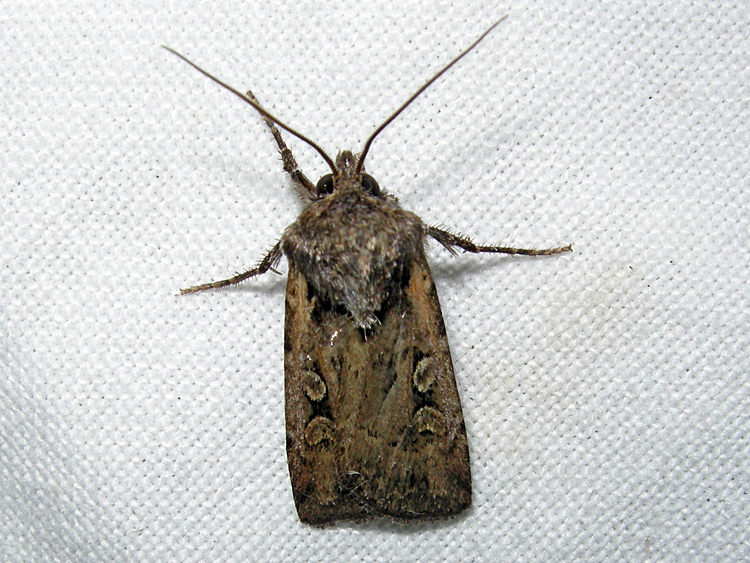White-line Dart Euxoa tritici
In Norfolk this species seems to be commonest around the coast, in the Brecks and in Norwich - it's rather local elsewhere (based on records showing at the Norfolk Moths website).
This is not a species I catch at home very often and so when I caught this one I held it back so that I could double-check the ID characters in the light of day. It would have actually proved straightforward to get it to White-line Dart based on external characters but I was really busy at the time and didn't get round to examining it properly until it had died. As it was dead I decided to check its genitalia, and that's where it got complicated! The genitalia seemed to be a better match for Garden Dart. According to the Difficult Species Guide the basal spines on the ovipositor are longer and stronger on Garden Dart and Square-spot Dart than on White-line Dart. I've got to say that the images at the Moth Dissection website don't really support this but mine had long and strong spines as shown in the Difficult Species Guide for Garden/Square-spot Dart.
The shape of the bursa copulatrix is also important for this group - the guide uses this to separate Garden Dart from Square-spot Dart, not White-line Dart, but illustrates it as being quite different in White-line Dart. The images in the Moth Dissection website mostly support this, with it being narrower, more oblong and round-ended on White-line Dart. Of course it's a difficult structure to set and it can change shape on compression so we need to be a little careful, but on mine it was broad and triangular with one long side very straight, just like it should be on Garden Dart. It actually looks a bit more rounded in the photo taken after I had put the cover slip on (and therefore a bit more like Square-spot Dart) than it did before I did so - I had a good look at it from different angles and it looked better for Garden Dart before finishing the prep.
So could it be a Garden Dart? I don't think so. I gather that the taxonomy of this group is not yet fully settled and it may well be that we have more than one species masquerading as White-line Dart, but until such time as they're separated I think this must be called White-line Dart. At least if it hadn't been dissected I don't think anyone would have disagreed with that conclusion, so at least it's as good a White-line Dart record as any that aren't dissected (which I imagine is the vast majority).
, North Elmham, 23-Jul-18 (A) (1).jpg)
, North Elmham, 23-Jul-18 (A) (5).jpg)
, North Elmham, 23-Jul-18 (A) (9).jpg)
female White-line Dart Euxoa tritici showing genitalia, North Elmham (Norfolk, UK), 23rd July 2018
The next one I caught at home was a male. Again it was a straightforward ID as White-line Dart based on external characters but intrigued by the last one I decided to see what its genitalia looked like. The extensions to the sacculi were symmetrical ruling out Coast Dart (no surprise there). I was undecided about the juxta - compared to the illustrations the central notch looks longer than on White-line Dart and more like shown for Garden Dart (Square-spot Dart is meant to be like Garden Dart but looks short like White-line Dart in the plate in the Guide to Difficult Species). Measuring the notch vs. total length of the juxta it seems to be right on the overlap of the two (three) species. The sub-basal diverticulum of the everted vesica is long like Garden (and Square-spot Dart?) and quite wrong for White-line Dart. I'm less clear about the differences in the diverticulum between Garden Dart and Square-spot Dart.
So the genitalia do not appear to fully conform to any of the species using the criteria in the Guide to Difficult Species. Is this because it's an entirely different taxon, or is White-line Dart simply more variable than the guide suggests? In any case I am fairly sure that based on the external appearance alone, based on current understanding of taxonomy most people would agree it was a straightforward White-line Dart.
 (1).jpg)
 (3).jpg)
 (9).jpg)
 (11).jpg)
 (2).jpg)
 (7).jpg)
 (8).jpg)
 (6).jpg)
male White-line Dart Euxoa tritici showing genitalia (including aedeagus before and after being everted), North Elmham (Norfolk, UK), 23rd July 2018
I caught this one just a few days later and its genitalia was similar to the last one except that the sub-basal diverticulum was less clear. Arguably that makes it a better fit for Square-spot Dart rather than Garden Dart, and no different for White-line Dart, but I did not do such a tidy job of everting the vesica and I think that may have affected it.
 (1).jpg)
 (2).jpg)
 (3).jpg)
 (4).jpg)
 (5).jpg)
male White-line Dart Euxoa tritici showing genitalia, North Elmham (Norfolk, UK), 29th July 2018
I dissected this male too, but I don't think I did a very good job of it as I don't have any photos of the genitalia. My notes say genitalia examined rather than 'gen det' (determined) which implies that my identification was based primarily on the external appearance rather than genitalia.
, Weybourne, 5-Jul-19 (A) (1).jpg) ">
">
, Weybourne, 5-Jul-19 (A) (2).jpg)
male White-line Dart Euxoa tritici, Weybourne (Norfolk, UK), 5th July 2019
The following were all identified in situ based on the external appearance alone.
 L.JPG)
 L.JPG)
White-line Dart Euxoa tritici, Buxton Heath (Norfolk, UK), 13th August 2011
 L.JPG)
White-line Dart Euxoa tritici, Kelling Heath (Norfolk, UK), 6th August 2011
 (1).JPG)
White-line Dart Euxoa tritici, Weybourne (Norfolk, UK), 21st July 2017

White-line Dart Euxoa tritici, Winterton dunes (Norfolk, UK), 18th August 2012

White-line Dart Euxoa tritici, Winterton dunes (Norfolk, UK), 19th August 2017
 L.JPG)
White-line Dart Euxoa tritici, Bawdeswell (Norfolk, UK), 21st August 2019
.JPG)
White-line Dart Euxoa tritici, Brancaster (Norfolk, UK), 18th July 2015
